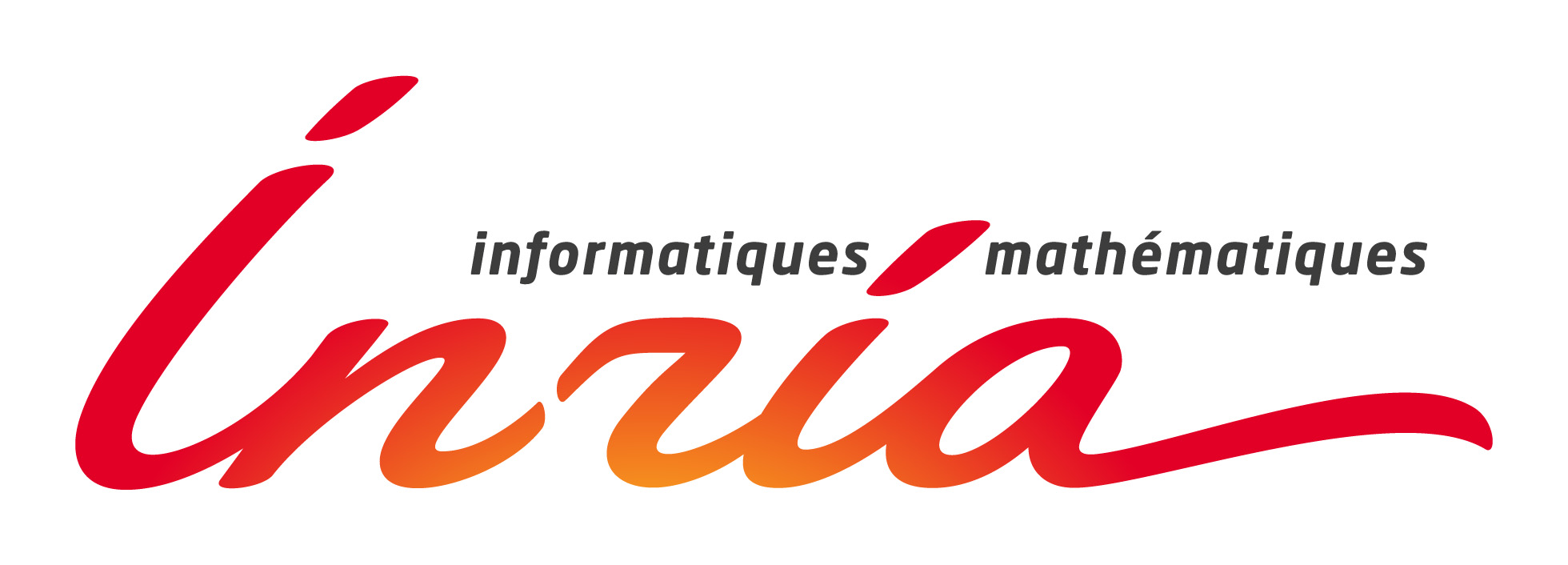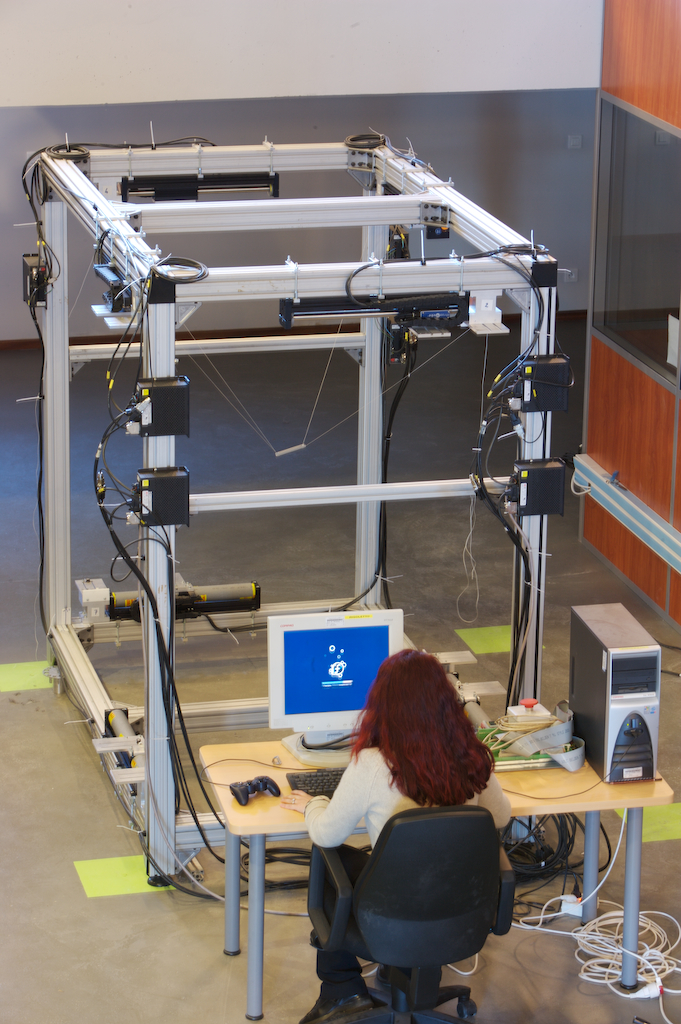

COPRIN - Wire-driven parallel robot - intensive course

January 14 - January 18 2012
The aim of this one week intensive course is to give the students an overview of various aspects related to wire-driven parallel robots.
It is organized in 6 half days courses. The last half day is devoted to the applications of various notions on real robots. The course will be delivered by members of the INRIA team COPRIN.
Venue
INRIA, Centre Sophia Antipolis Méditerranée.
Building Kahn, room K3
Schedule
Monday morning Introduction J-P. Merlet afternoon Modeling and Symbolic Computation Y. Papegay Tuesday morning calibration D. Daney afternoon Passive joints and application examples, T. Gayral Wednesday, morning Visual servoing, R. Ramadour afternoon free Thursday, Morning Uncertainties management, O. Pourtallier afternoon Hands-on on prototypes J. Alexandre-dit-Sandretto and L. Blanchet Friday, morning Exam ( room K2 - 9:00 am - 11:00 am)

Introduction

Monday January 14-th, 9:00am - 12:00amIn this introduction we will present wire-driven parallel robots and their numerous potential applications (such as assistance, rehabilitation, haptic devices, virtual reality, industrial maintenance, etc..) which justify the recent interest in such robot. We will summarize the state of the art and present open issues in this field. We will show that there are still major unsolved problems in kinematics (which involves solving systems of non-linear equations), motion planning, singularity, calibration. We will also show that such inexpensive robot may be a wonderful tool to illustrate difficult theoretical concepts in several domains, some of which are apparently far away from robotics.(slides)
Modeling and Symbolic Computation

Monday January 14-th, 2:00pm - 5:00pmModeling a (robotic) system is the first and mandatory step to achieve whenever one is interested in the mechanical or dynamical behaviours of such system. Defining the pertinent physical entities, selecting a formalism to attach variables to them, then writing equations expressing the physical laws produce a first kind of symbolic model. It then has to be made explicit using numerical schemes or symbolic solvers to become useful for simulation and visualization of results.
All these activities will be explained and demonstrated in the particular and practical case of a 3RPR parallel robot.Calibration

Tuesday January 15-th, 9:00am - 12:00amAs a result of defects in manufacturing or assembly, it is well known that the geometry of robotic manipulators does not exactly match the design goals. As a direct consequence, the accuracy of the manipulator is reduced, because robot control heavily relies on a precise description of the kinematic model. One way to tackle this problem is to improve the theoretical kinematic model by means of kinematic calibration. This procedure allows an identification of kinematic parameters through redundant information on the state of the robot provided by measurement, viewed as constraints on the kinematic parameters. This course present the basic methodology of calibration thought simple parallel robot example.(PDF document )
Passive joints and application examples

Tuesday January 15-th, 2:00pm - 5:00pmA robotic system is composed of several joints, passive or actuated, that permit the robot motions over its work-space. Analyzing the specific motions allowed by the joints and the way they are assembled in the kinematic links of the robot is of prime importance in order to understand how the robot is moving. In a first part, we will see how we can model each joint to describe a robot. Then, we will introduce the modified Denavit-Hartenberg parametrization which is a practical and very useful way to analyze the robot motions. Finally, we will extend those principles to the modeling of more complex joints such as flexible links, more and more used in today's robotics.Visual Servoing

Wednesday January 16-th, 9:00am - 12:00amDo androids dream of electric sheep ? Probably not yet, but they can see, recognize and count them, and they can move toward them.
You probably ask yourself : Ok ! But how ? By using vision-based control - also known as visual-servoing.
You are not totally convinced ? We use it daily in our lab. Adding a camera to our cable-driven robot, we are able to move it toward an object of interest in order to grab it.
You probably don't feel the need to have your robot chasing electric sheeps, but what if it is able to find your lost keys ? to clean your table ?
By introducing different approaches (image-based, position-based and hybrid methods) and their theoretical context (concepts like interaction matrix, features, ...), I will try to give you a first taste of what is possible. The second part of the presentation will consist in short exercises. But you will need some proofs, so there will be some demonstrations, and also a short introduction to the quite useful library ViSP.
The applications are endless. Ask yourself what you would like your robot to do, and how vision can help you. This is where we will start from.
I also invite you to take a look at these references : [1] [2] [3]
Those of you who would be interested in testing with their own computer, I invite you to install ViSP : ViSP (a Linux distribution would be preferred)Uncertainties management

Thursday January 17-th, 9:00am - 12:00amIn real systems uncertainty sources are multiple and do not share the same characteristics. Also tolerance to these uncertainties depends upon the problem and what kind of answer is expected when studying it. A consequence of that is the multiplicity of approaches available to handle uncertainties and the choice of a particular one depends strongly upon the problem at hand and the terms in which the solution of the problem is expected. In this course we will analyze the different uncertainty sources related to cable wire robot. A focus will be done both on interval analysis approach and on a game theory approach.Hands-on on prototypes

Thursday January 17-th, 2:00pm - 5:00pmHands on! You got explained what a wire-driven parallel robot is, and different tools to study it. Well, let's try them shall we? In those practicals, we will study the robot top to bottom, including: the wires, by putting your practical scientific skills at use; the winches, by the use of mathematics and mechanics; and also the control of the winch and the command of the robot, using your top-notch programming skills! To complete the circle, at the end of the practical we will make an attempt to fuse all of the results you gathered and introduce you to the main research topic on wire-driven parallel robots.
